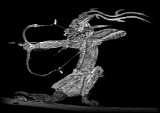
Asian Traditional Archery Research Network (ATARN)
Photographs © Dale A. Proctor, 2003.
A1, Cloudridge,
30, Plunkett’s Road,
The Peak, Hong Kong.
Fax: (852) 2808-2887
email: srselby@atarn.org
September 2003
Dear All,
Here I am back in harness after spending a month in England. Apart from riding and doing some archery, I had the chance to visit the Simon Archery Collection in Manchester and the Royal Armouries at Leeds.
In Manchester, Mrs. A. Wendy Hodkinson, Hon. Keeper of Simon Archery Collection, kindly showed me around the new display by . Unfortunately, the reserve collection items have not yet been un-packed, so I shall have to make another visit next year to see them. (Not at all unfortunate, actually.) The items on display are not great in number; but they are well displayed. I would have liked to see a stronger story-line: the main message that came across was that there is great diversity in bow designs, but there is insufficient space to allow visitors to understand the deeper implications of that, and what the reasons might be.
The display also covers crossbows in some detail, including a Chinese repeating crossbow.
If ATARN Members with a specialist interest plan to visit, I strongly suggest making contact with Wendy Hodkinson in advance, as she has a great deal of knowledge and an explanation from her would provide a much-needed supplement to the descriptions shown in the display cabinets. (Manchester Museum also has a fine Egyptian collection. For the second time (in Geneva also), I saw Chinese Warring States period trilobate bronze arrowheads in a Roman era Egyptian collection.
On to Leeds in the North of England where Hilary Greenland of the Society for Promotion of Traditional Archery (SPTA) had organized a traditional archery event at the Leeds Armoury.
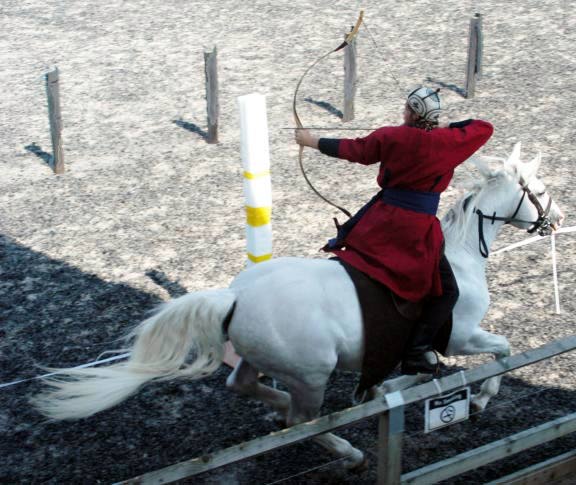
Christian Schrade doing a 'Parthian Shot'
Photograph © Caroline Collins 2003
Such fun! First, Hilary had laid on an excellent display of traditional bow-making – concentrating on how horn bows are made. Secondly, there was an exciting display of equestrian martial arts in the tilting (jousting) yard at the Armoury. Apart from mediaeval European tilting, lance and sword work on horseback, there was a comparison of the speed of reloading between a matchlock musketeer and an archer (in Saracen armour). No bets on who won! Then there were displays of Japanese horseback archery (Andrew Bodley) and Kassai-style modern horseback archery (Christian Schrade and Martin Knight).
I thought I knew a lot about Chinese bronze crossbow locks. I have written before on the different types of Chinese crossbow locks that I have encountered. So when Dale A. Proctor sent me this photograph -

I told him that he had an early Warring States bronze crossbow mechanism; but while the sear and trigger are present, the lock and axles are missing.
I couldn't have been more wrong! This is a two-element mechanism: trigger and sear with no lock (although it is still missing the axles.) Dale followed up with these photographs and drawings showing how it works:
|
|
|

Oblique view
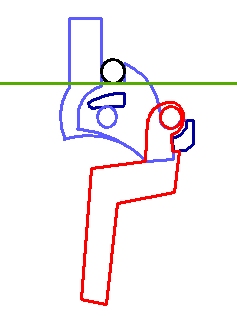 Locked |
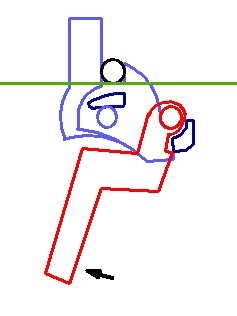 Triggered |
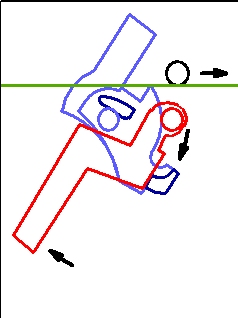 Released |
Drawings © Dale A. Proctor, 2003
Dale writes:
“This unusual Chinese crossbow lock consists of only two elements, which can best be described as a sear and a trigger. They would be mounted in the crossbow stock on two axles. The sear is mounted on the rear axle and the trigger on the forward axle. The two sides of the sear are connected together near the rear axle and at the very front. The forward sides of the sear hook under the forward axle and are then connected to each other in front. The portion connecting the two sides of the sear at the front is hollowed to accommodate the eye of the trigger and fit into the notch just beneath the eye. When the trigger is pulled back the sear is released from the notch and rolls around the rear axle, down and forward, releasing the string.
“When cocking, the string is pulled back until it contacts the rearward sighting pin or cocking lever on the sear. This rolls the sear back up to the cocked location and the trigger will fall forward and lock it – even when the crossbow is horizontal. The dog leg in the trigger keeps it out of the way of the falling sear and places the portion you would pull to the rear.
“I presume that there was some kind of stop for the sear carved into the stock, otherwise it continues past the dog leg in the trigger and will jam the mechanism when you try to cock it.
“Some observations which are only my own opinion: I doubt whether it was mounted in a box in the stock, as the catches on such mechanisms usually have a flat portion designed to strike the bottom of the inlet for the box. It could have had a box that mounts on the exterior of the stock – or no box at all.
“In comparison to the more usual Chinese crossbow locks, this one probably has less than half the leverage, making it most suitable for lighter crossbows.
“Some of the proportions and the construction of the sear are so similar to the more usual lock that I strongly feel that the maker made both kinds of crossbow locks.”
This sort of two-element lock is described for European crossbows in Payne-Gallwey: "The Crossbow", Longmans, Green & Co., 1903; but none of the reference materials I have come across describe a Chinese one. From the stocky shape of the sear and trigger, I would date it no earlier than Qin. Crossbow mechanism design had changed radically by the Tang Dynasty, so I would put it as some time between 200BCE and 400CE.
I am looking forward to reading your views on ATARNet.
All photographic records of Qing Dynasty Chinese archery technique are precious, so I was delighted receive this page from 'Asia' Magazine of 1935.
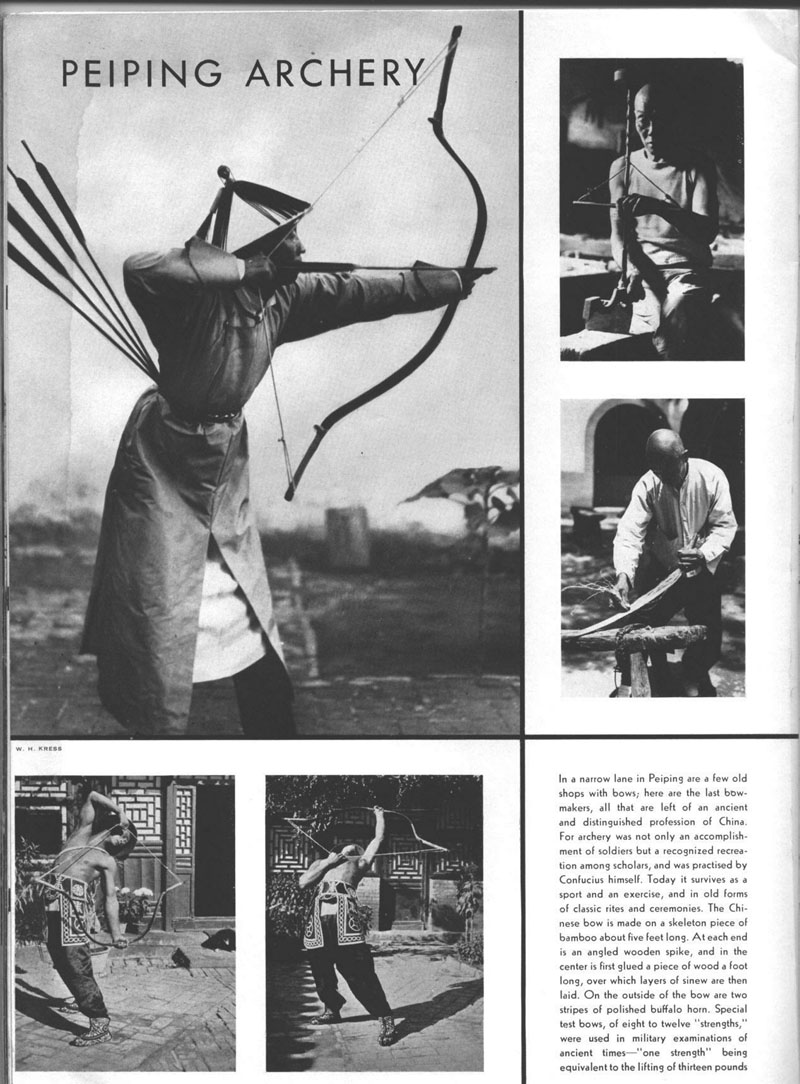
Although the magazine edition dates from 1935, the photograph on the top left, attributed to W. H. Kress, has the archer in Qing military uniform. This certainly would not have occurred in the thick of the Nationalist period, so the photograph must date from the time of the fall of the Qing dynasty. And the top right hand photographs are clearly related to this one. ('Die Grosse Völkerkunde' by Dr. Hugo A. Bernazik, published in Leipzig in 1939.)
I am also able to relate the following, previously unattributed pair of photographs, and thus they must also be by W. H. Kress.
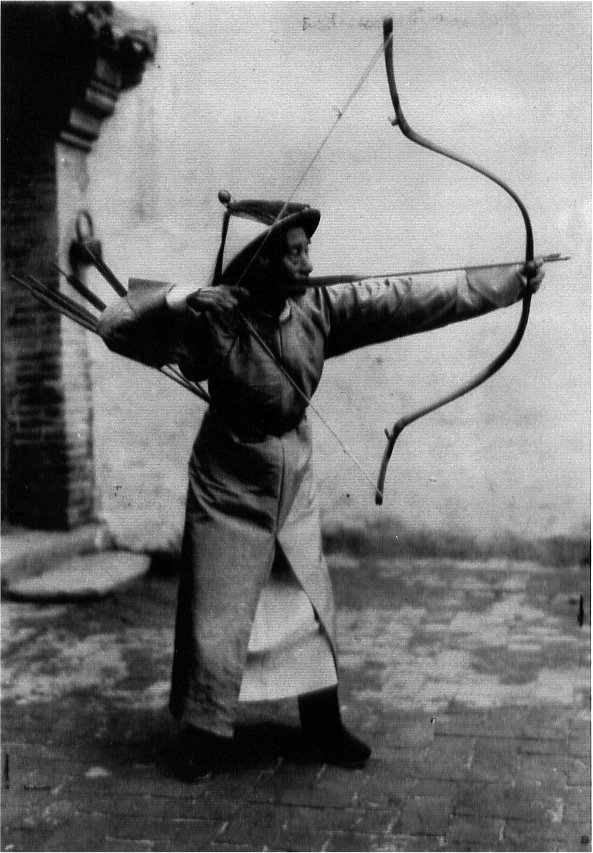
Chinese archer in Qing officer's summer dress.
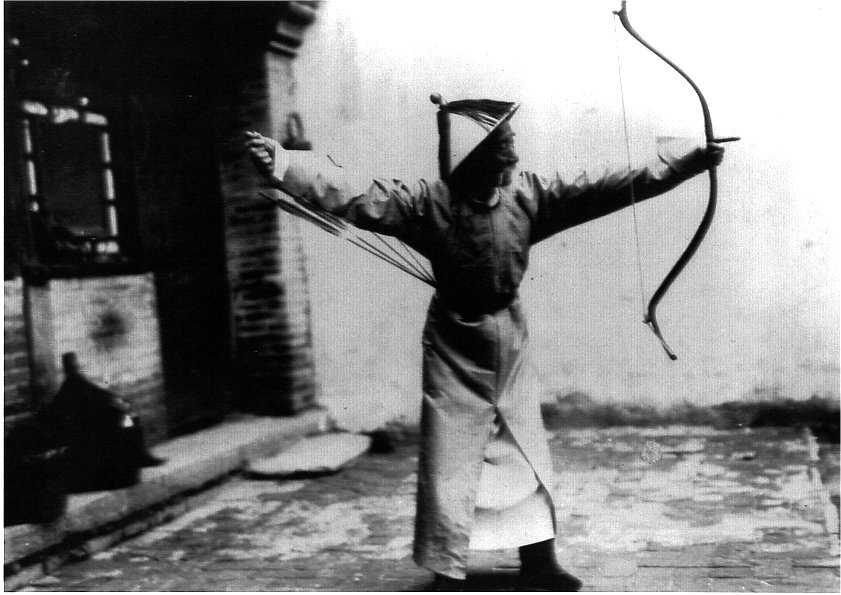
The follow-through immediately following the release.
Please let me know if you have information about W. H. Kress.
Not long ago, I posed a question to Members about how to shoot a pellet bow. Now Bob Brown has come up with an explanation. Bob is a long-time member of the Soc. Archer Antiques and editor of their newsletter 'Arrowhead'. This explanation is also due to be published later by the SPTA, and I am including it in this newsletter with their kind permission.
SHOOTING A PELLET BOW
by Bob Brown
Following an article in the SPTA Newsletter, I discovered the website for 'ATARN' which have found very interesting. One of the things I spotted was that Stephen Selby was learning to shoot a pellet bow. Done that and got it working, and since I noted that he was coming North to the Horse Archers Event at the Royal Armouries Leeds, I thought I would go over there and show him and see the horse archers too. Alas, the dates clash. I shall be hurtling south to the Antiquarian Shoot of the Society of Archer-Antiquaries as he comes north.
Many moons ago (late 1960s) I saw a TV programme about village life in Southern India. In it there was a boy with a pellet bow shooting clay pellets. During an obviously staged scene, he shot at an eathenware pot slung under the eaves of a hut to keep the contents cool. He shot it from a guesstimated 15 feet and hit the pot nearly dead centre. The pellet went straight through and water fountained out of entrance and exit holes over the elder sitting beneath.
I was impressed by both the power and accuracy of the bow and decided to have a go. About that time I had acquired a beginners recurved bow made from a single flat-sectioned piece of ash with some idea of trying my hand at backing it with sinew. But it was light - about 20 pounds at 24 inches and converted to a pellet bow very nicely. The Indian one shown in the programme was made from a section of large diameter bamboo; about 3 feet long and had a double string with pouch. Pellet bows are known throughout S.E. Asia and China in one form or another.
My string was made from window-sash cord formed into a bowstring-length, endless loop with a bound knot join. Binding the two skeins together below the eyes at each end formed the eyes.
The two skeins were held apart by two (6mm) notched dowel separators about 1" (25mm) long set about halfway between the pouch and the nocks. I reasoned that if things went horribly wrong, I could drive a pellet into my bowhand and decided to set the pouch about 2 in. (50mm.) above my bowhand position (a wise precaution as it turned out). My first attempt at a leather pouch was just the width of the separation and 1" deep. This was too narrow to give a good grip on the pellet. The second attempt worked. This time I cut a much longer strip, sewed it onto one skein and made a pouch, put a pellet in it and held it and measured where it reached the other skein, then sewed that side to the bowstring.
Out to the garden to have a go. A part draw and a twist (to the right) of the bowhand on the loose - smack - the small stone hit the bow. Tried again, with a more forceful twist - the stone careened off the edge of the bow. Retired to house to pad bow with a covering of sisal string and leather for about 4 inches (10 cms.) above bowgrip. After some practice I could get about half of my shots past the bow.
Took it up to the archery club to show off. Several of us had seen the programme. Another chap had made up a pellet bow too. Found the same problem and come up with a solution.
It may not be the only solution or a classic solution but it works.
The trick he developed was to hold the bow firmly so that the bow and string are aligned about 45° to your bow arm.
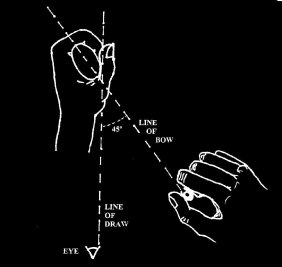
Drawing © Bob Brown,
2003
The loose was a simple pinch grip. On the loaded (bulging) pouch this was able to be much firmer than on the narrow nock of an arrow on the string. Then draw to the eye - not the side of the face - so that you are looking at the target over the pouch and loose. The pellet then goes round the bow (to the right for a right-handed archer) and the string goes back to the 45° alignment.
The bows didn't seem to suffer from this gross misalignment although I do not know how it would affect Stephen Selby's Chinese pellet bow, which I understand, has siyahs (fixed ears). [Stephen says: 'Actually, my pellet bow doesn't have long, static ears.'] Oriental composite bows with siyahs do NOT take kindly to lateral twists. A lateral twist is multiplied by the leverage of the siyahs, twisting the bow-limbs which take a set (requiring correction). If a set occurs there is the very real danger of the string dismounting from the siyahs, on the loose (dangerous to bow and archer) and the bow becoming unstrung and reversing.
Ammunition. Initially, small pebbles were our ammunition but later we used ˝" lead ball cast from a musket bullet mould. The lead ball ammo was splendid and wreaked havoc on tin cans up to about 40 feet (12m.) and that was when there were proper tin cans, not these modem ones you can crush in one hand. With some practice we became very accurate indeed.
As with any form of archery, if you try using a pellet bow, take care. SAFETY IS PARAMOUNT.
The Hong Kong Asian Traditional Archery Festival is definitely on from 24-26 October! Support from ATARN Members has been fantastic (especially given the inconvenience of re-scheduling due to the SARS outbreak.) Jaap and Kay Koppedreyer, Bert Grayson, Bede Dwyer, Ju Yuan Hao and many other denizens of the Internet will be here in Hong Kong with archers from Bhutan, Korea, China, Tibet and Mongolia. We have hotel rooms with breakfast available from US$97 per night. Hong Kong is bouncing back after SARS and there are many bargains to be had. Why don't you come and join the fun?
|
|
(Signed) (Stephen Selby) |